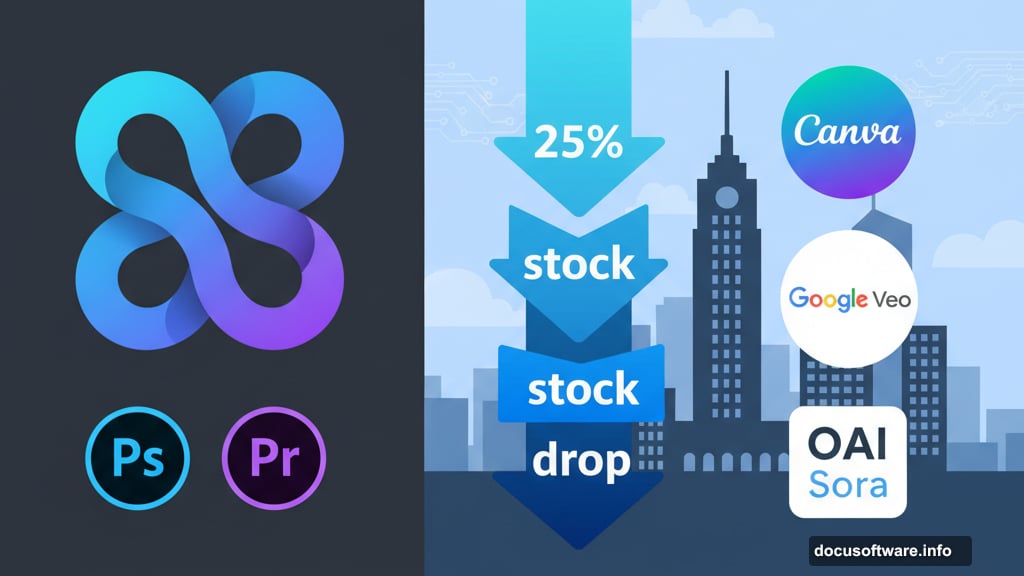Adobe just held its annual conference. Tens of thousands of creators showed up. But the company’s real problem wasn’t in the crowd—it was on Wall Street.
Investors are panicking. Adobe’s stock dropped 25% this year while AI competitors exploded onto the scene. Now the creative software giant faces a brutal question: Can it survive when anyone can generate professional content using free AI tools?
The Threat Nobody Expected
Adobe spent decades building a creative software empire. Photoshop became synonymous with image editing. Premiere Pro dominated video production. Creative Cloud seemed unshakeable.
Then generative AI changed everything practically overnight.
Today’s reality hits hard. Scroll through social media and you’ll see videos created with OpenAI’s Sora. Party invitations designed in Canva. Professional-looking content made by people who never touched Adobe products.
That’s not theoretical disruption. It’s happening right now.
Citi analyst Tyler Radke warned that Adobe faces “structural competition and pricing pressure driven by AI.” Translation: The company’s entire business model might be obsolete.
Why Creators Are Leaving Adobe Behind
The numbers tell a disturbing story for Adobe. While the company touts “hundreds of billions” of AI feature uses in Photoshop, many popular AI tools come from competitors.
Google’s Veo video generator attracts millions of users. Canva’s template-based design tools exploded in popularity. OpenAI’s image generators create stunning results instantly. None require expensive Creative Cloud subscriptions.
Plus, these tools keep getting better. Each month brings more capable AI models that close the quality gap with professional software.
Adobe CEO Shantanu Narayen insists the market undervalues his company. He argues investors focus too much on semiconductors and AI training while ignoring application software. But that argument misses the point.
Investors aren’t worried about Adobe adopting AI. They’re worried AI might eliminate the need for Adobe altogether.

Adobe’s Risky Strategic Pivot
This week’s conference revealed Adobe’s response: Surrender the AI model race entirely.
The company announced it would integrate competitor AI models—including Google and OpenAI—directly into Photoshop and other tools. Instead of competing with these tech giants on AI development, Adobe becomes their distributor.
That’s a massive strategic shift. For years, Adobe promoted its Firefly AI model as safer and more reliable than third-party alternatives. The company emphasized copyright protection and content safety as key differentiators.
Now? Adobe admits customers want access to all AI models, regardless of source.
Ely Greenfield, Adobe’s CTO for Creative Business, explained the new reality: “People have gradually accepted that models require training on vast amounts of data.” He added that customers use Firefly for final published content but prefer third-party models during creative ideation.
That distinction matters. It means Adobe’s own AI technology serves a secondary role in the creative process.
The Revenue Story Gets Murky
Adobe claims AI-focused products generate over $250 million annually. But the company quickly adds that figure doesn’t capture AI’s full impact.
So Adobe invented a new metric: “AI-driven revenue.” This broader measure estimates that AI technologies contribute approximately $5 billion annually through higher pricing and reduced customer churn.
That’s convenient accounting. It’s also a red flag for investors who prefer concrete numbers over creative bookkeeping.
KeyBanc analyst Jackson Ader noted that conference attendees responded positively to third-party AI integration. He stated: “We endorse this strategy; previously, we questioned whether Adobe could maintain a competitive edge in AI-driven image and video generation.”
That endorsement reveals the problem. If Adobe can’t compete in AI generation, what exactly is it selling? Access to other companies’ technology through a familiar interface?
What Adobe Still Has Going For It
Despite the challenges, Adobe retains serious advantages. Professional creators invested years mastering its tools. Major studios standardized on Adobe software. Enterprise contracts lock in long-term customers.
Plus, Adobe’s integration strategy might actually work. Most professionals don’t want to juggle multiple AI tools across different platforms. A single interface accessing all major AI models offers genuine value.
The company’s focus on copyright safety and content moderation appeals to risk-averse enterprises. Free AI tools might impress casual users, but corporations need legal protection and content controls.
Moreover, Adobe still dominates complex professional workflows. Nobody’s creating feature films or magazine layouts in Canva. Advanced color grading, motion graphics, and print production require Adobe’s depth.
The Uncomfortable Truth
Adobe’s real competition isn’t other professional tools. It’s the democratization of creativity itself.
When anyone can generate professional-looking content using free AI tools, who needs $60-per-month Creative Cloud subscriptions? That question haunts Adobe’s investor presentations.
The company argues it serves professional creators who need advanced features. True enough. But that market is way smaller than the mass market of casual creators who once needed Adobe but now have alternatives.
Evercore ISI analyst Kirk Materne suggested this year’s conference took “another critical step in addressing market concerns about whether generative AI poses an existential threat.” But taking steps and solving problems are different things.
Adobe faces a shrinking addressable market as AI tools replace the need for complex software. Integrating competitor AI models might retain existing professionals, but it doesn’t expand Adobe’s reach or justify premium pricing.
The company isn’t dying. But its growth story fundamentally changed. Instead of owning the creative tools market, Adobe fights to remain relevant as AI reshapes who creates content and how.
That’s why investors remain skeptical despite Adobe’s clear strategy. They see a company adapting to survive rather than thriving in the AI era. And Wall Street punishes companies that shift from growth to survival mode.
Adobe will likely persist as a professional tool provider. But the explosive growth that once drove its stock valuation? That era probably ended when free AI tools proved anyone can be a creator.
